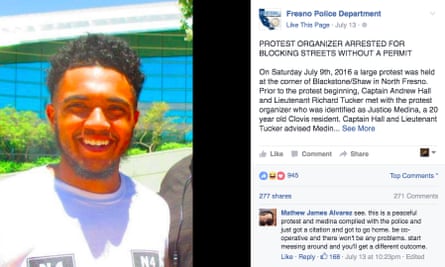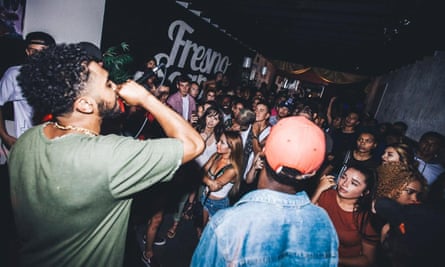When Justice Medina left a Black Lives Matter protest in California last Wednesday, police followed him. At around 8pm, roughly a mile away from the protest in downtown Fresno, officers stopped the 20-year-old, who was in a car with his mother.
“They had trailed behind me, and they pulled me out of the car and handcuffed me,” recalled Medina, who is black and Mexican and grew up in the Central Valley city, 200 miles south-east of San Francisco.
“I was shaking,” recalled his mother, Mysti Medina, 38, who also participated in the rally against police brutality. “I’ve been pulled over and harassed by cops before, but this was very scary.”
The police – who confirmed the Medinas’ version of events – eventually took the handcuffs off Justice and gave him a citation for two misdemeanor charges stemming from his protests: “Obstructing the sidewalk” and holding a “special event” without a permit. If convicted, he could face a year in jail and a $1,000 fine.

Activists were stunned; two weeks earlier, the same police department had made no arrests and issued no citations when a group of anti-police protesters took over the streets without a permit, blocking traffic in a similar manner.
The main difference? The first rally was a “White Lives Matter” protest.
The Fresno department has faced international scrutiny in recent weeks after officers fatally shot a white, unarmed teenager during a traffic stop. The 25 June shooting of 19-year-old Dylan Noble, which was caught on graphic body-camera footage, led to widespread condemnation, but also inspired a “White Lives Matter” rally.
While Noble’s killing has raised serious questions about the department’s use of lethal force, the police response to the ensuing protests led by white people has also shed light on what activists say is a pattern of police disproportionately targeting communities of color.
‘No confrontation’ with White Lives Matter
The night of Noble’s death, his friends gathered at the Chevron gas station where he was killed, and an impromptu vigil eventually morphed into a chaotic protest against police.
According to officers and protesters, some started setting off fireworks and doing “doughnuts” and “burnouts” with their cars – driving in circles and spinning their wheels. Some shouted “fuck the police” and eventually a crowd took over the road, standing with their arms in the air blocking traffic. One protester allegedly threw a glass object at police.
The event made national headlines after some protesters held up a Confederate flag and “White Lives Matter” sign – an appropriation of the Black Lives Matter movement that seeks to raise awareness about the high rates of police violence against African Americans.
Friends of Noble said the protests were misunderstood and that they were only trying to draw attention to the unjustifiable and horrific killing by police.
Police, meanwhile, were deliberately passive in their response to the protest.
“We do everything we can to de-escalate the situation,” police chief Jerry Dyer told the Guardian days after the rally. “There was absolutely no confrontation.”
One officer even allowed a protester to use the police loudspeaker to address the crowd, which a local TV station caught on camera.
“Tempers were flaring on both sides,” recalled Bryce Lindlahr, the protester who used the police PA system to encourage the crowd to be peaceful and focus on mourning their friend.
There were no arrests or citations, according to police captain Andy Hall, and the gathering dissipated.
US commentators quickly drew comparisons to police responses to Black Lives Matter protests, which have ended in mass arrests and teargas.
But activists did not have to look as far as New York City or Ferguson, Missouri, to make claims about unequal treatment of minority protesters.
“If I walked up to a police car and tried to use their PA system, I wouldn’t be talking today,” said Floyd Harris Jr, a reverend and black activist in Fresno.
‘A double standard’
Harris, 45, founder of the civil rights group International Network in Action, has marched in several Black Lives Matter protests in Fresno in an effort to push for increased accountability in the local police agency.
At a 10 August 2015 protest, police closely monitored the reverend’s movements, records show.
“Mr Harris willfully entered the roadway and maliciously obstructed the free movement of many individuals,” a police report read. “In addition the use of loud speakers and protest chants were threatening and annoying to citizens attempting to freely utilize the roadway.”
Later, Harris was charged with obstructing the streets and organizing an “unlawful event” without a permit. Two other activists, a black woman and a Latino woman, also faced traffic violation misdemeanor charges for their involvement in the protest, records show.
Harris said the protest attracted large crowds, including white residents, but that the police targeted people of color for prosecution.
“It was really more about silencing me for bringing attention to Fresno.”

After a public fight over the charges, Harris and city officials eventually negotiated a deal in which the reverend agreed he would not demonstrate in the streets without a permit for a year, at which point the city would dismiss charges.
Harris thought the agreement was harsh and that police should spend more time working to prevent deadly shootings by officers instead of wasting resources going after protesters.
“It’s OK for black and brown children to be murdered, but I’ve got to get permission to exercise my constitutional right?”
Harris became particularly furious, however, when he saw how police were apparently kind to white activists at the Noble protest – letting them block traffic without facing consequences and even giving them a microphone to amplify their message.
“It’s just a double standard,” Harris said.
It was Justice Medina’s very first protest when he learned that local police don’t always let activists take to the streets with impunity.
‘They want to silence me’
After police recently killed black men in Baton Rouge, Louisiana, and Falcon Heights, Minnesota, – in two cases captured in disturbing videos – Justice wanted to help raise awareness in his community.
On 9 July, he and more than 500 others marched in the streets of Fresno shouting “No justice, no peace” and “Hands up, don’t shoot”.
Police monitored Justice’s actions and later got a warrant for his arrest. A few days later, officers tried to deliver the citation at his house. Unable to reach him there, officers spotted him at a second Black Lives Matter protest and handcuffed him after following him and his mother on their way out.
“I do have a target on my back,” said Justice, who is also an aspiring rapper. “I’m just trying to bring the community together. They want to silence me.”
The department even published Justice’s photo on its Facebook page with the title “PROTEST ORGANIZER ARRESTED” and posted video of him on YouTube.
Hall, the Fresno police captain who oversees protests, said the Black Lives Matter rally that led to Medina’s citations was a threat to the public.
“It was frightening to block that much traffic,” Hall said. “I understand they’re against us. I fully appreciate it. That’s OK … But my goal is to allow the protest, but do it in a way that does not put anyone’s life in danger.”
Hall claimed that the reason the “White Lives Matter” protest didn’t end in citations was that it was “spontaneous” and didn’t last very long. He said the department uniformly targeted protest leaders who plan and execute illegal street closures, and that it’s unlikely they would ever serve jail time.
Activists said it would be better if police consistently exercised the restraint they showed white protesters at Noble’s vigil.
“If white people can protest in the street without permits, they should let black and brown people do the same thing,” said Robert Navarro, a Fresno civil rights attorney who has represented the Rev Harris.
Justice and his mother said they would not be deterred by the police’s citations.
“Words can’t express how proud I am,” said Mysti. “He’s trying to help his community. Why are [the police] trying to tear him down?”
